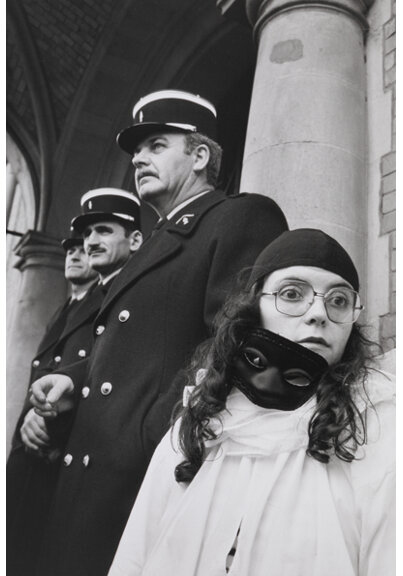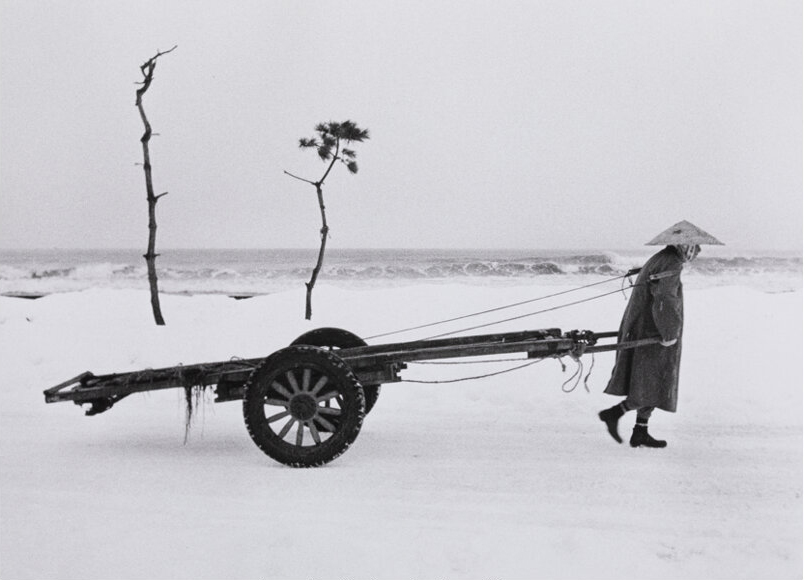|
|

|
Nigel's Picks
Director, Photographs, New York
|
Koudelka’s image captures the tense relationship between Roma communities and local populations. It shows a young Roma man, a suspect in a recent murder, standing in the street during a police reenactment. Koudelka emphasizes the man’s solitary figure, with his anxious, uneasy expression contrasting starkly against the backdrop of police officers and onlookers gathered behind him.
Over a decade documenting Roma communities across Czechoslovakia, Romania, Hungary, France, and Spain, Koudelka deeply embedded himself in their lives. His affinity for their traditions and lifestyle granted him unique access and fostered a profound empathy for the Roma people and their nomadic culture. This empathy is palpable in the photograph, highlighting the complexities of the community’s relationship with the Slovakian authorities. This image has since become one of the most recognized in Koudelka’s acclaimed series.
|
|

|
Antanas Sutkus’ photograph of a young Pioneer standing alone in front of a group of fellow students, Ignalina, 1964, captures a nuanced portrait of Soviet-era youth. The young boy, dressed in the Pioneer uniform with its distinctive red scarf, stands apart, facing the camera with a blend of innocence and quiet determination. The separation between him and the group behind him adds a subtle tension, emphasizing the boy’s individuality amidst the collective. Sutkus, renowned for his empathetic eye, brings out the boy's introspective gaze, suggesting a personal narrative and inner life that exists beyond the imposed Pioneer identity. The composition underscores the delicate balance between the ideals of conformity and the resilience of personal identity during this time.
Through this powerful image, Sutkus invites the viewer to reflect on the impact of ideological pressures on youth in Soviet Lithuania. The Pioneer uniform, meant to symbolize unity and loyalty to the state, contrasts with the boy’s distinct presence, highlighting the quiet persistence of individual spirit. Sutkus’ photograph transcends simple documentation, revealing the emotional landscape of Soviet-era childhood, where personal identity was often subsumed under collective expectations. By focusing on this lone figure standing before his peers, Sutkus comments on the complex dynamics of individuality within a society structured around conformity, creating an image that resonates as both a historical record and a universal meditation on the self.
|
|

|
Laura's Picks
Consignment Director, Fine & Decorative Arts, New York
|
Two of my choices from this auction are by British photographers whose best-known work documents the so-called “Thatcher Years” when Margaret Thatcher was the UK’s Prime Minister in the late 1970s and 1980s. Love her or loathe her, the nation under her leadership became a polarized place; London and the south of England prospered while the industrial north foundered, its communities facing unemployment and poverty as traditional manufacturing industry disappeared around them. Chris Killip’s work Cookie in the Snow, 1984
, one of many works by him in this sale, literally and metaphorically captures the zeitgeist of these difficult, transitional times. The subject of this gorgeous composition, “Cookie” struggles against the inclement wintry weather of the landscape and his circumstances.
|
|
Graham Smith and Chris Killip are friends whose photographs reflect a similar preoccupation and sensibility , although Smith’s photographs have a more pragmatic and objective quality than Killip’s unashamedly poignant studies of the struggles of the British working class. In this work, Smith has created a dynamic image of a child swinging from a rope, dangling dangerously high above the polluted River Tyne. It is impossible to misinterpret Smith's intent in creating this picture; here, a child's natural search for excitement and adventure is depicted. He always provides a lengthy handwritten caption on the back of each print to explain what we are looking at. Smith retired from photography in 1991, after receiving negative reviews from some of the British press to his joint
show with Chris Killip at MoMA, New York and so this is a rare opportunity to see and acquire his work.
|
|

|
While perhaps not the most significant Cartier-Bresson in this auction (his early scrapbook photograph Barcelona for the MoMA retrospective in 1947 has that honor), this image is more meaningful because it is one of a series of photographs that sparked my initial interest in photography and its “artistic” possibilities. I first saw the image at the Edinburgh Festival in around 1993, one of The Metropolitan Museum’s extraordinary The Waking Dream
traveling show. Without knowing anything about Cartier-Bresson’s “decisive moment” modus operandi, I was completely engaged by the photograph’s enigmatic composition and perspective. What’s actually going on here? Who is this young woman with a mask around her neck who seems alarmed by the presence of the gendarmes above her (who in turn seem unaware of her?) Is she a bystander at a traditional regional parade or part of a demonstration? Cartier-Bresson’s simple and characteristic habit of naming his photographs by where he took them offers no clues.
|
|

|
Holly's Pick
Director of Modern & Contemporary Art, San Francisco
|
Josef Koudelka's Gypsies series captures the lives of Roma communities across Eastern Europe during the 1960s and early 1970s, a period marked by both hope and hardship under Communist regimes. Immersing himself in their daily lives, Koudelka documented moments of cultural pride and struggle. In one evocative image, Zehra, Czechoslovakia, 1967, young boys flex their muscles in an exaggerated show of bravado, offering insight into the performance of masculinity in childhood. Their slender frames convey both a desire to project strength and an underlying vulnerability, encapsulating the complexities of growing up amid adversity.
|
|

|
Toshiko's Picks
Cataloguer, Fine and Decorative Arts, New York
|
After his photographs documenting the Prague Spring, which became an international sensation, Josef Koudelka fled the country in 1970, which was the start of his exile. He might have seen himself as one of the Gypsies, his primary subject from his early career, moving from one place to another with little to carry. He was wandering around Europe while awarded numerous grants to continue his projects and published books like Gypsies in 1975 and Exiles in 1988. Reflecting on his experiences of being exiled, his photographs often project desolation, alienation, and isolation in the faces and gestures of people in dark black and white landscapes, sometimes quite dramatically. This image, Falling Snow,
taken in 1978, is beautiful without the presence of people, just snow accumulating on the road surface and blowing snow in front of the camera projected by the light in the dark, irresistibly making us feel it corresponds to the photographer’s inner reality.
|
|

|
Kiichi Asano was born in Kyoto, Japan and started taking photographs in the 1930s and spent most of his years capturing the beauty and tradition of this old capital city, where people's lives blend within the landscape. He traveled out of Kyoto to Hokuriku and Tohoku regions in northern Japan in the 1950s and was fascinated to see people living in a severe wintry climate with deep snow. It is interesting to compare this with the well-known Hiroshi Hamaya's body of work, the "Snow Country" series from the 1940s, a decade earlier. Hamaya's keen eye as a photojournalist interested in folklore drove him to a sharper documentary approach, capturing the harsh but vivid lives that held the community together with traditional rituals in the darkness. Asano's "Snow Country" has more sunlight and
feels slightly warmer. Perhaps because they are taken a decade after the war, but also because the photographer's eye captures the beauty of the unity of the landscape and their lives. When Asano was documenting this series, these lifestyles of rural areas were vanishing. Asano's love for finding the past's mature beauty in the present must have moved him more. There is an engaging self-portrait of the photographer in this setting, sitting on a pile of snow with a cigarette in hand, enjoying a break.
|
|

|
|
Nigel Russell
Director, Photographs
New York
NigelR@HA.com
(212) 486-3659
|

|
|
Holly Sherratt
Director of Modern &
Contemporary Art,
San Francisco
HollyS@HA.com
(415) 548-5921
|

|
|
Laura Patterson
Consignment Director,
Fine & Decorative Arts,
New York
LauraP@HA.com
(212) 486-3525
|
|

|
|
Toshiko Abe
Cataloguer, Fine &
Decorative Arts
New York
ToshikoA@HA.com
(212) 486-3523
|
|
|
|
|
|
|
|
|
|